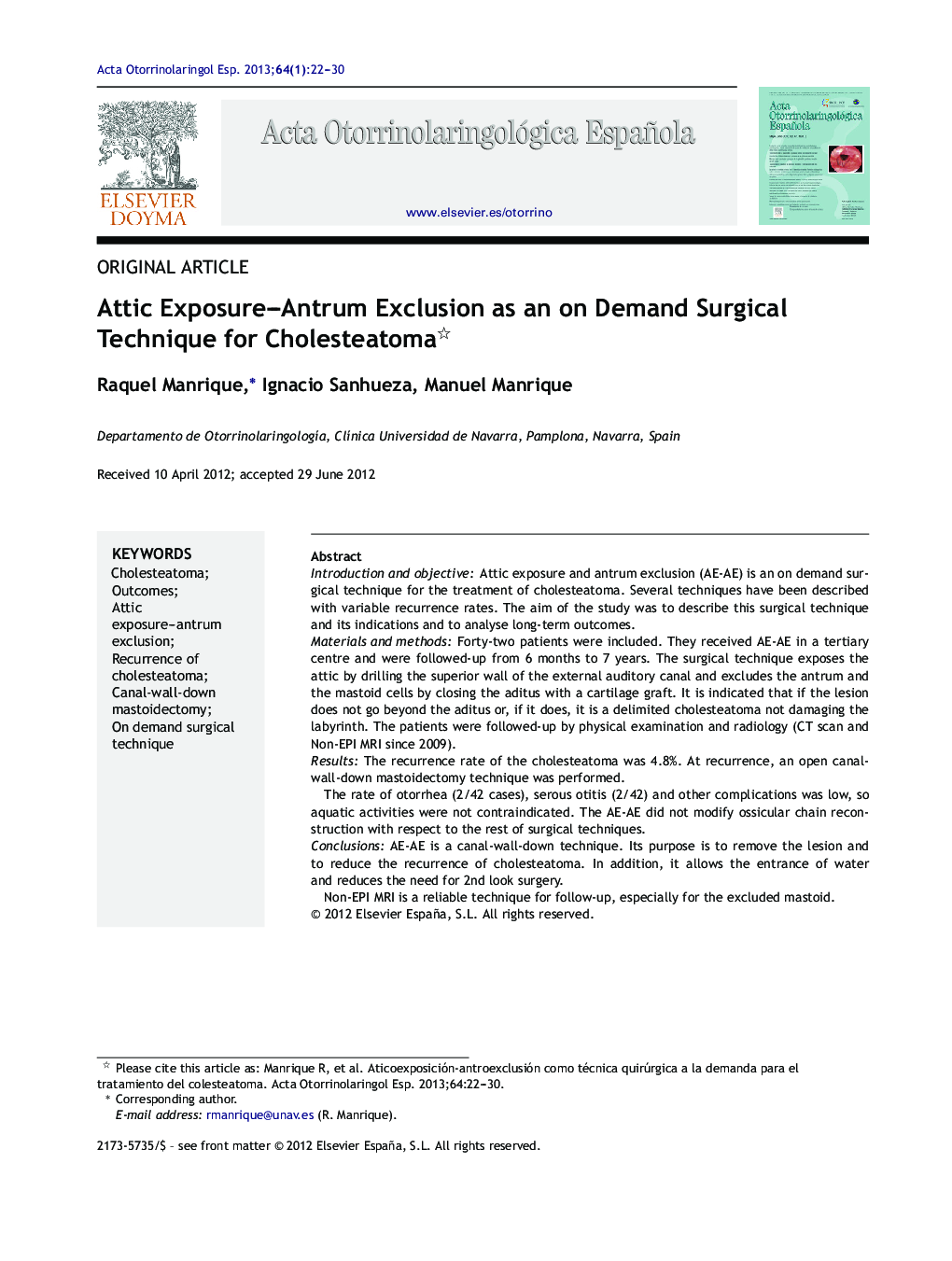| Article ID | Journal | Published Year | Pages | File Type |
|---|---|---|---|---|
| 4100826 | Acta Otorrinolaringologica (English Edition) | 2013 | 9 Pages |
Introduction and objectiveAttic exposure and antrum exclusion (AE-AE) is an on demand surgical technique for the treatment of cholesteatoma. Several techniques have been described with variable recurrence rates. The aim of the study was to describe this surgical technique and its indications and to analyse long-term outcomes.Materials and methodsForty-two patients were included. They received AE-AE in a tertiary centre and were followed-up from 6 months to 7 years. The surgical technique exposes the attic by drilling the superior wall of the external auditory canal and excludes the antrum and the mastoid cells by closing the aditus with a cartilage graft. It is indicated that if the lesion does not go beyond the aditus or, if it does, it is a delimited cholesteatoma not damaging the labyrinth. The patients were followed-up by physical examination and radiology (CT scan and Non-EPI MRI since 2009).ResultsThe recurrence rate of the cholesteatoma was 4.8%. At recurrence, an open canal-wall-down mastoidectomy technique was performed.The rate of otorrhea (2/42 cases), serous otitis (2/42) and other complications was low, so aquatic activities were not contraindicated. The AE-AE did not modify ossicular chain reconstruction with respect to the rest of surgical techniques.ConclusionsAE-AE is a canal-wall-down technique. Its purpose is to remove the lesion and to reduce the recurrence of cholesteatoma. In addition, it allows the entrance of water and reduces the need for 2nd look surgery.Non-EPI MRI is a reliable technique for follow-up, especially for the excluded mastoid.
ResumenIntroducciónLa aticoexposición-antroexclusión (AE-AE), simple o ampliada, es una técnica a la demanda para el tratamiento del colesteatoma. Las tasas de recurrencia/recidiva descritas con diferentes técnicas quirúrgicas son variables. El objetivo de este estudio es describir la técnica quirúrgica, sus indicaciones y analizar los resultados a largo plazo.Material y métodosSe incluyen 42 pacientes intervenidos de AE-AE en un centro terciario con un seguimiento de 6 meses-7 años. Esta técnica expone completamente el ático fresando la pared superior del conducto auditivo externo y excluye el antro y mastoides cerrando el additus con injertos de cartílago. Se indica en pacientes con colesteatoma localizado en la caja timpánica sin sobrepasar el additus ó en caso de hacerlo estar encapsulado sin erosionar la cápsula laberíntica. El seguimiento es clínico y radiológico (TC peñascos y RM con secuencias de difusión desde 2009).ResultadosEl 4,8% de los casos presentó una recidiva, los cuales fueron rescatados en un segundo tiempo quirúrgico. En el seguimiento la tasa de otorrea (2/42), otitis serosa (2/42) u otras complicaciones fue baja, no contraindicando las actividades acuáticas. La AE-AE no modificó el tipo de reconstrucción osicular respecto a otras técnicas.ConclusionesLa AE-AE es una técnica abierta. Pretende eliminar totalmente la lesión y reducir la recidiva de colesteatoma, facilitando una normalización en los baños y una disminución de revisiones postquirúrgicas.La RM en secuencias de difusión es una técnica fiable en el despistaje y seguimiento, especialmente para el control de los espacios mastoideos tras la AE-AE.
